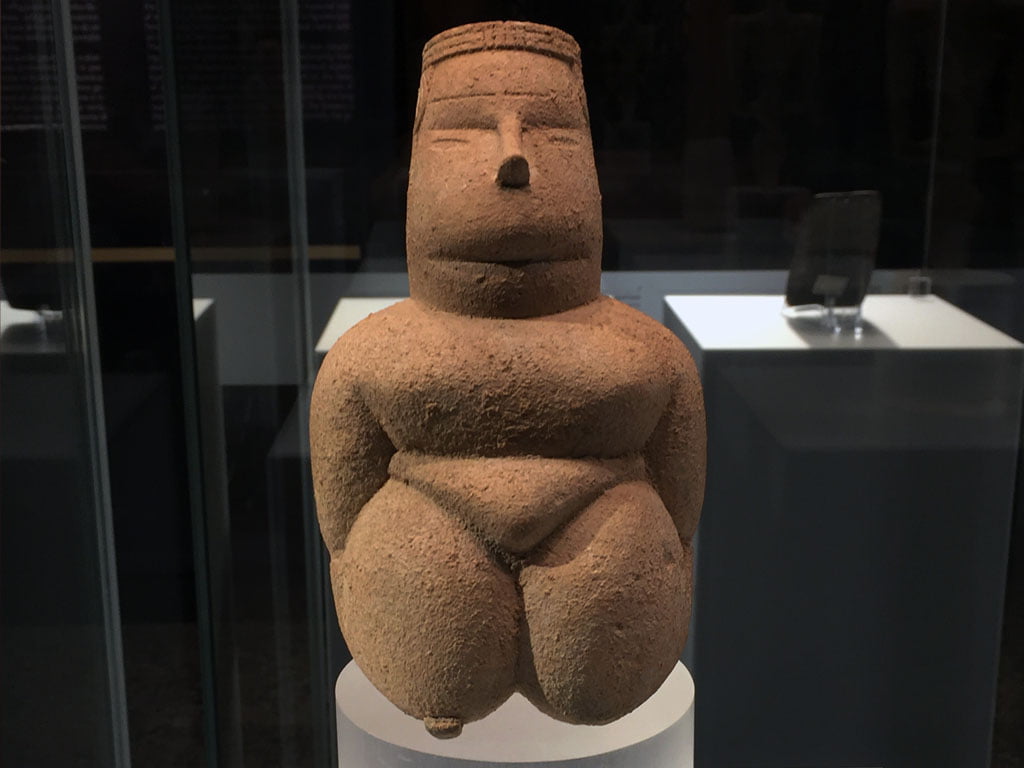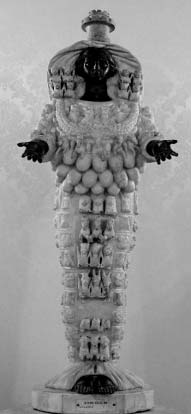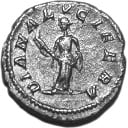di Sarah Perini
Adapted from Marija Gimbutas - Twenty years of Goddess study - Proceedings of the conference of the same name – Rome 9-10 May 2014 – Laima Editorial Project – Turin
In this intervention I will analyze the contribution of an Italian researcher of the last century, unknown to most, but at the forefront of matrifocal studies and ancient Mediterranean religions. Due to the brevity required by this intervention, I will limit myself to a didactic and descriptive intervention taken from the two currently available texts that collect the work of Momolina Marconi. Its first publication of 1939, Mediterranean reflections of the most ancient Lazio religion, is currently available online on Filarete, the website of the University of Milan, Faculty of Letters and Philosophy. The critical reissue of the researcher's essays was published in 2009 by Edizioni Venexia, edited by Anna de Nardis: From Circe to Morgana, written by Momolina Marconi.
Momolina Marconi (1912-2006) was a teacher from 1948 to 1982 at the State University of Milan together with her mentor and fellow researcher Umberto Pestalozza, from whom she inherited the chair of History of Religions. Her work is connected to that of great international researchers such as Jane Harrison, Mircea Eliade, Karl Kerenyi; and while not meeting Marija Gimbutas, she amply confirms her research lines and results.
In fact, Marconi and Pestalozza write in the period between the two world wars, unlike Gimbutas who works after the war; the two were defined by contemporaries as "convinced Mediterraneans", because they described a peaceful and luxuriant Ancient Europe from a social, cultural and religious point of view.
Marconi is the only Italian female voice that gives a contribution that is still considered current today on the sacred feminine, rediscovering the Italian and Mediterranean roots of the multifaceted Mediterranean Lady: One and Multiform Goddess, Sacred Virgin, Lady of vegetation and animals, Mother of Life and of death.
Unlike Marija Gimbutas, who is an archaeologist, Marconi is a literate, she starts her research from the collection and analysis of the literary and religious sources of the Mediterranean peoples, relating to the forms and cults of the Great Goddess.
The time frame taken into consideration starts from 3000 PEC and reaches up to the Middle Ages. The geographical area analysed, defined as "Mediterranean", covers a very vast territory which extends from the western limits of Europe to India.
Marconi underlines the existence of a unitary female deity throughout this vast area, with different names but with common characteristics. Specifically, she identifies some forms: the naked goddess; the goddess showing her breasts; the goddess holding or suckling; the bird goddess; the serpent goddess; the dove goddess; the goddess potnia of plants and animals; the goddess lucifer.
In pre-Roman Italic and Latin religion he finds the following female divinities: Fortuna; good goddess; Mother Matuta; Feronia, and Diana. Among the most widespread Mediterranean deities he indicates: Isthar, Astarte, Inanna, Hathor, Artemis and Athena.
Finally, he compares the most famous priestesses and sorceresses from antiquity and the Middle Ages: Circe and Medea, Morgana and the Lady of the Lake, in close connection with the Great Mediterranean Goddess of which he claims they are a direct manifestation. Let us now analyze these figures of goddesses.
The Goddess showing her breasts
The oldest representation of the Mediterranean Goddess is a buxom, naked woman in the act of emphasizing the shape of her breasts or pubis, with very pronounced hips, legs and buttocks, symbols of fertility and the power to give life.
We also find it in cylindrical and bell-shaped forms or anthropomorphic vases; in rounded or flattened shapes (the latter connected to funerary cults). Geometric signs often appear around the energetically powerful areas of her body (breasts, pubis, belly, navel, head, eyes, neck, arms, legs).
The Goddess is also depicted with the head of a bird or a snake; her while she holds snakes in her hands; standing upright on a lioness, lion, or beast; in a sitting or squatting position. She holds or squeezes her breasts with her hands; or with one hand she squeezes a breast and with the other a ritual vase in which she collects her milk which she gushes, or she feeds an animal; she is dressed in a long sheer or dotted gown, sometimes veiled or bejeweled with bracelets, tiaras, torquises, belts, coiffed up with braided hairdos or long plaits.
In some later forms we find the Goddess represented next to her companion, paredro, lover, subordinate son who reveres her or accompanies her during the ritual.
The Goddess who holds or nurses
The Mother Goddess more properly so called is represented to honor divine and human motherhood, the power to give life, nourishment and healing. Universally present starting from the Neolithic and in all subsequent eras, passing from Hathor to Isis to Ephesia up to Maria.
The Goddess is represented in an upright or sitting position holding one or more children; she suckles her creatures or keeps them close; small or large children come up to her or hold them on her shoulders or on her head; she is seated on simple chairs or on thrones held up by fairs. This Goddess too can have the head of a snake, a bird or a cow.
In nature it is surrounded by animals such as: snakes, doves, birds, cows, pigs, sheep, goats, fairs. In his hand he holds fruits such as apple and pomegranate or eggs or sceptres surmounted by eggs or doves.
The Goddess is not subject to wedlock although sometimes she is accompanied by a subordinate young god, son, brother or lover who assists her in sacred functions.
Goddess Potnia

She is the most significant and central figure in the cult of the Mediterranean female deity as she represents all aspects of it.
Goddess of the vegetable and animal world, connoisseur of healing herbs, protector of fairs and wild animals of aquatic ones and birds; guarantor of the natural life cycle and fertility.
She appears naked or dressed in a dress or with a long or short flounced skirt, with a tight or open bodice over the breast; with jewels on neck and arms; coiffed with braids, sometimes with a conical hat. Often winged; sometimes armed with a double ax or arrow, tools used to defend the animal or vegetable kingdom and not to hunt; (sometimes standing with a simple scepter or surmounted by a dove or egg).
Represented between mountains or in a luxuriant vegetal landscape (poppies, lilies, palms, flowering festoons, branches, ears, oaks or typical trees depending on the area).
Symbols of the moon, sun, stars, tripods, rays and even columns or stones erected or decorated with vegetable festoons often appear next to her, symbols of the Goddess even when she is not represented. In some cases she holds snakes in her hands or they intertwine with her body; at other times she holds lions, lionesses, deer or birds by the paws. She sits on wild beasts, on swans or geese, even in flight.
It is represented surrounded by animals such as: snakes, bulls, deer, rams, goats, billy goats, horses, bears, bees, doves, swans, geese, ducks, roosters, fairs (lions, lionesses, lion cubs, leopards, panthers), birds of prey.
Sometimes equipped with musical instruments: zither, cymbals, flutes and horns used both to tame animals and to celebrate fecundity festivals or seasonal rituals.
Often accompanied by female figures of her priestesses or Amazons, later replaced by knights or human couples.
His bearded companion, young or old, is his paredro, son, lover, brother, helper; he supervises vegetation, is often in connection with horses; often symbolized by a male deer, a woodpecker, a rooster.
The Goddess of Serpents

The Goddess of snakes is a specific figure connected to the power of the snake, this animal has a particular relationship with the Goddess Potnia and with her powers of management of creative, sexual and chthonic energy; she is also the keeper of the healing power of poisons which combined with plants can bring death or life.
The snake is connected with the power of transformation, with movement, with the regeneration of vital energy and participates in the power of the Goddess of creation of life is a symbol of fertilization, fertility, growth. The parts of the Goddess's body where the snake often climbs are those where the energy of the human body also flows powerfully: head, neck, arms, hands, belly, back, legs.
The Dove Goddess
The dove is the bird that most often accompanies the Goddess Potnia and the individual manifestations of the great Mediterranean divinity, such as the Mesopotamian Ishtar, the Syro-Phoenician Mother Goddess, the Cretan and Cypriot Mother Goddesses, the Greek Aphrodite and numerous figures of priestesses, such as Semiramide and others.
She appears naked, but more often dressed in a long dress or flounced skirt, with a dove in her left or right hand or in both hands or near her breast or on her head; with doves approaching her. She can hold a scepter surmounted by a dove in her hand or be represented only by a column surmounted by a bird. Other animals present may be: snakes, bulls and deer which represent the masculine fertilizing energy.
Symbols connected to her are: eggs, pomegranates, festoons of flowers and fruit.
The Goddess is represented standing or outside or even inside small temple buildings or buildings populated by doves; these small temples were dedicated to fertility cults and later to sacred sexual unions; while the rock dovecotes to the funerary cults where the dove ensured the regeneration of the soul of the dying who took up residence in it.
The goddesses Ishtar, Astarte, Cybele are the Anatolian and Middle Eastern forms of the same original divinity found in the western Mediterranean and which together with Aphrodite will later be connected to the fertility cults as guarantors of the cycle of rebirth and love and the dove it will become its primary symbol.
Ephesia, the many-breasted Goddess
Ephesia, Artemis Ephesina, Diana of Ephesus is present in the areas of Anatolia, Mesopotamia, Greece, Italy in the form of terracotta, marble, stone, bronze statues; some of these statues are constructed so that liquids flow from the sinuses.
She appears naked or dressed in a particular sheath dress, long to the feet, very narrow which leaves only the rows of multiple breasts uncovered; she also wears open jackets and long or short skirts, as in the case of the goddess of snakes or the goddess of lions and mountains.
Sometimes it is winged and its upright position, with arms clasped and hands turned outwards, emphasizes the breasts and the offer of nourishment. His animals are: doves, bees, bulls, lions, deer, goats, birds, but also mythical creatures such as sphinxes, griffins, sirens.
Its symbols: gnarled staffs, sceptres surmounted by birds, spears, staves, bows, wreaths, palms, triangles. It too is later associated with the moon and star Venus.
The statue shown in the image is one of the copies of the cult statue of Artemis venerated in the sanctuary of Ephesus, known to us only from reproductions and especially from the coins issued by the city's mint, starting from the Hellenistic age. The goddess stands rigidly upright, almost looking like a xoanon, and she extends her arms; on her head is a polos in the shape of a tower with arched doors, on the sides of which emerges a disc, decorated with four protomes of winged lions on her side; on her chest he wears a breastplate on which are, in bas-relief, the zodiacal signs of Leo, Cancer, Gemini, Libra and Sagittarius, and a necklace from which acorns descend; her bust holds four rows of breasts, as a symbol of fertility, or, according to others, the scrotums of the bulls ritually sacrificed to her; on the legs the close-fitting dress is decorated, in the front part, with protomes of winged lions, bulls and horses, in a strong protrusion, within five superimposed squares, and, along the sides, by winged sirens, rosettes, sphinxes and bees, repeated, the latter, also on the lower band of the garment, where it lets the underlying tunic appear, which opens like a fan on the feet; finally, her sleeves are decorated with three rampant lions.
The Goddess Lucifer
She is the Goddess who brings light into the wood who supervises the life of the animals and the safety of the sacred place with her torch; she is the bearer of the apotropaic and purifying fire with which she frees the sacred wood from any negative influence and watches over the fecundity and health of the animal and vegetable world; fire which also possesses fertilizing properties.
In the most ancient form she is represented unarmed with the torch in one hand and the ritual dish in the other. Later depictions appear with the crescent moon on her head, connected to the lunar phases and the effects on the natural and feminine cycles.
She is represented on foot or on horseback with long but veiled dresses that show her body or with short dresses, sometimes with wings; with long or short torches.
Accompanied by horses, deer, dogs, snakes, wild beasts, winged panthers, griffins.
Sarah Perini
Adapted from Marija Gimbutas - Twenty years of Goddess study - Proceedings of the conference of the same name – Rome 9-10 May 2014 – Laima Editorial Project – Turin







